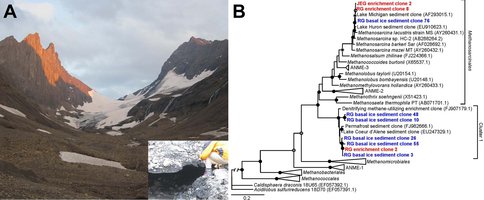2009 Annual Science Report
 Montana State University
Reporting | JUL 2008 – AUG 2009
Montana State University
Reporting | JUL 2008 – AUG 2009
Subglacial Methanogenesis and Its Role in Planetary Carbon Cycling
Project Summary
Methanogens are thought to be among the earliest emerging life forms. Today, the distribution of methanogens is narrowly constrained, due in part to the energetics of the reactions which support this functional class of organism (namely carbon dioxide reduction with hydrogen and acetate fermentation). Methanogens utilize a number of metalloenzymes that have active site clusters comprised of a unique array of metals. The goals of this project are 1) identifying a suite of biomarkers indicative of biological CH4 production 2). quantifying the flux of CH~4~ from sub-ice systems and 3). developing an understanding how life thrives at the thermodynamic limits of life. This project represents a unique extension of the ABRC and bridges the research goals of several nodes, namely the JPL-Icy Worlds team and the ASU-Follow the Elements team.
Project Progress
Various genetic, biochemical, and geochemical biomarkers unique to methanogenic archaea including 16S rRNA and methyl Coenzyme M (CoM) reductase genes, glycerol dialkyl glycerol tetraether lipids, CoM, and methane (CH~4~) have been identified in association with the subglacial sediments beneath Robertson Glacier (RG), Canada, indicating the presence of an active assemblage of methanogens. To specifically examine the metabolisms that are supporting methanogenesis, sediment-containing mesocosms were designed that contain various carbon source amendments as well as specific metabolic inhibitors of methaogenic metabolisms. Mesocosm gas-phase CH~4~ and CoM quantification and qPCR of specific 16S rRNA genes are being monitored as a function of incubation time. These data will be used to estimate the productivity of substrate utilization in the phylogenetically-distinct methanogen lineages that inhabit the subglacial environment at RG.
A collaboration between the ASU-Follow the Elements team has been initiated to examine the geochemistry of the subglacial environment. This data will be used to predict the energetic feasibility of various metabolisms in the subglacial environment, including various forms of methanogenesis. These predictive data will be used to evaluate the empirical data derived from the mesocosm studies.
The CH~4~ production and rates determined from mesocosm studies has been used to estimate CH~4~ flux from sub-ice environments, both on Earth and on Mars. These values were then used to estimate the potential role of subglacial methanogenesis in driving climate change during the Laurentide glacial cycle, and to evaluate the plausibility of sub-ice methanogenesis in generating the CH4 plumes released from the Martian subsurface during summer 2003.
As part of this node of the ABRC project, NPP fellow Boyd has given numerous seminars (NAS Committee on the Origin and Evolution of Life, NAI-EC meeting, East Carolina University astrobiology seminar series, Montana State University’s Thermal Biology Institute seminar series). In addition, Boyd will be presented two talks at the upcoming American Geophysical Union conference and is organizing a session at the upcoming AbSciCon conference.
Robertson Glacier, Alberta Canada looking South. Inset: sampling subglacial sediments from beneath the snout or terminus of the glacier. B). Archaeal 16S rRNA gene phylogeny of environmental clones recovered from Robertson Glacier basal ice sediments (blue) and from CH4-producing basal ice sediment enrichments from Robertson Glacier (RG) and John Evans Glacier, Alaska (JEG) (red).
-
PROJECT INVESTIGATORS:
-
PROJECT MEMBERS:
John Peters
Co-Investigator
Mark Skidmore
Co-Investigator
Matthew Urschel
Graduate Student
-
RELATED OBJECTIVES:
Objective 2.1
Mars exploration.
Objective 5.1
Environment-dependent, molecular evolution in microorganisms
Objective 5.2
Co-evolution of microbial communities
Objective 5.3
Biochemical adaptation to extreme environments
Objective 6.1
Effects of environmental changes on microbial ecosystems
Objective 6.2
Adaptation and evolution of life beyond Earth
Objective 7.1
Biosignatures to be sought in Solar System materials
Objective 7.2
Biosignatures to be sought in nearby planetary systems

